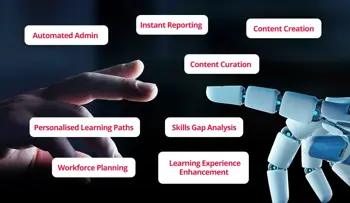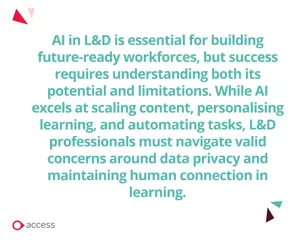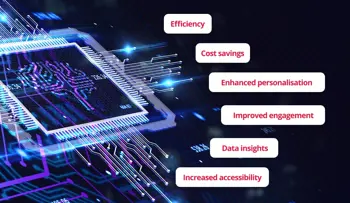How to Use AI in Learning & Development
With AI now firmly a part of the business landscape, how to use AI in learning and development has become a critical question for every L&D department.
It’s not just about offering training to upskill in AI itself, although that is a priority; KPMG reported that 66% of workers wanted to learn how to use generative AI in 2024. It’s about pinpointing how AI can enhance productivity across different types of jobs, how it can augment existing skills and where it can be used to either plug skills gaps or automate routine tasks. With 70% of business leaders fearing skills shortages are holding their businesses back according to Deloitte, organisations that are using AI in learning to upskill fastest will gain a competitive advantage.
Incorporating AI into L&D isn’t just a tactical move—it’s a strategic step toward building a future-ready workforce that can adapt, innovate, and thrive in a rapidly evolving environment.
But to get the best results L&D needs to understand both how to use AI in learning and development and where AI’s limitations lie.
For example: The opportunities to scale content creation and personalisation are huge. AI’s ability to automate routine tasks can free up L&D professionals for more strategic work, and its capability in testing and evaluating learning is impressive.
However, while many L&D professionals are embedding AI in learning strategies others are proceeding with caution. Concerns about data privacy, implementation and declining social learning are valid.
This article explores both the advantages and disadvantages of using AI in learning and outlines how to enhance L&D while minimising risks. Ultimately the aim of AI technologies is to enhance, not replace human-led learning initiatives, but to do so L&D need some foundational skills in AI themselves.
How can AI be used in L&D?
With the right tech and strategies, L&D can use AI to enhance the learning experience at every touchpoint in the employee lifecycle. But before diving into specific use-cases it’s worth highlighting the two different approaches to AI available.
L&D can either leverage:
- General-purpose, existing AI tools adapted for L&D purposes – think Claude.ai, ChatGPT, Elon Musk’s Grok etc. finessed for L&D
- Specialised learning software – LMSs, LXPs – enhanced with AI.
This article explores both approaches.
Content Creation and Curation
A much-lauded use of AI in learning and development is for content creation, with good reason: AI excels at generating and organising educational content.
For example, AI in learning can be used to:
- Create training materials, assessments, or role-playing scenarios with only bullet points as a starting place;
- Draft training webinar outlines;
- Generate discussion questions for team learning sessions.
AI can even boost employee engagement by summarising programmes and generating engaging emails about mandatory training and promote new upskilling opportunities.
Beyond creation, AI can curate existing content for specific learning objectives or audiences. By analysing materials and recommending relevant resources, AI can help L&D teams leverage their content libraries more effectively and ensure learners receive materials matched to their needs.
Personalised Learning Paths
Creating individualised learning experiences for every employee has long been on L&D’s wish list; now AI can turn it into reality.
AI-powered learning management systems analyse individual learner data (for example: past performance, job role, career aspirations, learning preferences) to recommend tailored learning paths.
Even better, these personalised journeys can adapt in real-time as learners progress, offering additional resources when needed or adapting the pace to match the learner’s level. For example, evolving learning paths based on individual performance and organisational requirements. This keeps people’s learning connected to the business’ strategy, ensuring each employee receives precisely the training they need to keep growing their career.
Skills Gap Analysis and Strategic Workforce Planning
Using AI in L&D can help the function contribute to strategic workforce planning initiatives. Firstly, an innovative use of AI in learning and development is to create an insightful, unbiased picture of the present. AI can be an effective tool to identify skills gaps across teams or departments and compare current capabilities against the future skillsets required. AI can also use industry trends to predict future skill requirements helping organisations stay ahead of evolving workforce needs.
Being able to use AI for this high level strategic view helps L&D leaders continuously create targeted learning and development programmes that develop the workforce in lockstep with the business’ needs, reducing the risk of skills gaps.

Learning Experience Enhancement
Previously, many eLearning programmes have had more in common with a university lecture: a one way broadcast where the learner listens instead of participating through debate or answering questions. Consider using AI in learning and development to make eLearning feel more like a back-and-forth discussion, or, with well-trained chatbots, a conversation with a knowledgeable guide. Chatbot assistants could even begin to offer encouragement when attention wanes, or, when requested, immediately rephrase wording so concepts are more easily understood, direct the learner to help or link to further resources. The interactive nature of this type of learning naturally boosts the learner experience and therefore engagement.
Another way to boost engagement is through AI providing direct delivery of essential work-related learning content. Policies and onboarding documents highlighted by a friendly Copilot in the flow of work can create non-intrusive, seamless experiences making mandatory training easy and painless to complete.
Automated Assessment and Feedback
AI systems can automate evaluation processes, providing immediate feedback that helps learners identify areas for improvement. These systems can assess not only ‘yes or no’ type questions but also more complex submissions like written assignments, verbal presentations or interview practice for internal mobility, just like a 1-1 mentor or development coach. By analysing learners’ response patterns, AI can offer constructive feedback that helps develop critical thinking skills and helps learners apply new concepts to real world situations, supercharging their development.
However, the obvious risk here is that individuals may begin using AI in learning tasks to fully create assignments or respond to end of course tests, meaning L&D must ensure that knowledge recall is tested within strict parameters to guarantee real learning has taken place.
Analytics and ROI Measurement: Measure what Matters
Analytics and reporting with increased ability via AI can track learner progress and engagement across programmes instantly, allowing L&D to correlate these metrics with on-the-job performance, eventually linking them to business outcomes. Reporting is accurate and immediate, saving vast amounts of time.
These insights help L&D teams demonstrate the ROI of their initiatives and draw the bright line between investing in learning and improved business results.

What are the key benefits of using AI in learning and development?
No matter whether you choose to use a general purpose AI tool or an AI-enhanced learning platform, using AI in L&D offers the following benefits:
-
Efficiency that saves L&D time and money
Tasks that once consumed hours — content creation, assessment grading, programme administration — can be partially automated. These efficiencies translate to cost savings and allow L&D to dedicate more time to high-value activities that only learning and development professionals can do, like enterprise programme design or executive coaching.
-
Enhancing personalisation increases engagement
Personalisation has long been the gold standard in effective learning, but delivering truly individualised experiences at scale was nearly impossible before AI in L&D. AI-powered systems can analyse individual learning patterns, preferences, and needs to deliver customised recommendations, adaptive assessments, and personalised feedback.
This personalisation boosts learning engagement and motivation. When employees feel learning experiences are relevant to their specific roles and goals, they're more likely to enthusiastically complete training and apply what they've learned.
-
Data-informed decision making in real-time
Hand-in-hand with digital delivery, AI can support L&D teams with detailed data about content engagement, knowledge retention, skill development, and programme outcomes. Best of all, AI can deliver these insights in real-time, informing decisions about learning strategies and resource allocation. So rather than relying on gut feelings or lagging indicators such as the annual promotion cycle, L&D professionals can continuously monitor effectiveness and make evidence-based adjustments.
-
Great accessibility and Inclusivity
L&D professionals have always known individuals learn best in different ways, using different modalities. AI makes learning more accessible through language translation, text-to-speech conversion, or providing alternative content formats such as audio and video at scale. These capabilities ensure learning opportunities are available to all employees, regardless of preferences or accessibility requirements.

What are the cons of AI in learning and development?
While AI brings many opportunities to organisational L&D, there are concerns and possible cons of AI in learning and development. Let’s explore.
Security and Privacy Concerns
A primary concern relates to data security and privacy. AI systems require substantial data to function effectively, and learner data is sensitive. So being clear on how L&D information is stored, processed, and protected is key when assessing AI enhanced systems.
This is one scenario where using a specific AI-enabled LMS outperforms open access AI tools. ChatGPT, Claude.ai et al may process data on external servers, whereas purpose-built L&D solutions such as those powered by Access Evo use a closed system approach. AI-enabled LMSs are more likely to offer enhanced privacy protections as well as support regulatory compliance.
Accuracy and Content Quality Issues
AI systems are only as good as their training data: every general purpose large language model comes with a warning to factcheck for hallucinations. Inaccurate or misleading content is particularly problematic in learning contexts, as incorrect information could adversely impact learner development and therefore job performance.
Additionally, AI cannot replicate the flair, empathy and unique qualities that people bring to learning content, and this can lead to bland, uninspiring content that garners low learning engagement.
There are three mitigations here, all related to the importance of human input and oversight:
- Training materials may be drafted at speed – by they need to be verified by L&D for accuracy and robustness;
- Using subject matter experts to help create training is a win-win – they can use AI to create the materials faster and are best placed to catch any hallucinations as well as bringing their unique knowledge.
- Ensure learning content outputs are enhanced to light up your learners’ engagement by the addition of video case studies of real people, and utilisation of story-telling techniques.
Ethical Considerations and Bias
AI systems can inadvertently perpetuate biases present in training data, potentially leading to unfair learning recommendations or assessments. For example, AI might consistently suggest certain training to specific workforce demographics based on encoded biases or historical patterns, rather than assessing the individual’s interests and potential.
Addressing these risks requires ongoing monitoring of AI recommendations, combined with diverse training data and explicit fairness criteria. Using AI systems that have been specifically developed for HR/L&D use cases may help mitigate the risk.
Diminished opportunities for social learning
Many organisations and sectors rely on social learning to embed cultural values and transfer knowledge. The UK’s legal profession mandates that would-be solicitors complete a two-year training contract which is usually done on-site, so fledgeling lawyers can learn from established partners.
Although most of the workforce is familiar with virtual learning – especially post-pandemic - some L&D practitioners believe excessive reliance on AI could diminish the opportunities for social learning. The ramifications extend across the whole of HR’s remit: social learning helps foster a culture of belonging at work and a culture of learning, aiding talent retention, attraction and employee engagement.
Modern digital learning solutions can effectively address some of these concerns with creating opportunities for human connection in learning. This can be achieved through:
- Interactive online experiences: Utilise live virtual classrooms or team-based gamification to encourage collaborative learning and friendly competition.
- Social recognition: Implement organisational social networks to enable managers and leaders to easily recognise and celebrate learning achievements, fostering peer engagement and social encouragement.
Implementation Complexity and the need for foundational AI Skills
Introducing AI systems into established L&D processes can be complex. And the fears about AI replacing people’s jobs have sparked resistance to using it. Additionally, the learning curve associated with AI has proved to be steeper than many originally imagined, contributing to the sense of ‘hype’ around AI.
Successfully implementing AI-enhanced learning strategies requires thoughtful change management processes, clear communication about the benefits and phased deployment approaches that allow people to adjust over time.
Mastering prompt engineering across different open-access LLMs as well as learning platforms that have been enhanced with AI will be a critical foundational skill for L&D departments. That itself is a challenge. But it is also an opportunity – L&D can lead by example and help role model the change the wider workforce needs to make.
We are excited about the possibility of having much more effective workflows and at the same time, we're being cautious because there are ethical considerations, but also accuracy considerations because we know that AI is still producing hallucinations. We're proceeding with caution but are very excited about where this could take us. The expectation is high in the L&D space but there’s a reality behind AI that we haven't quite set yet.
The trends in AI you need to be aware of as an L&D professional
By virtue of its nature, AI in L&D doesn’t stand still. Recent trends include adaptive learning systems that dynamically adjust content difficulty based on an individual learner’s performance, natural language processing for conversational learning interfaces, and ever-more realistic immersive simulations for virtual reality learning.
The AI skills gap in organisations is starting to become apparent and will only grow rapidly. As well as mastering AI for use in learning and development, it is essential that L&D teams predict and plan for upskilling the workforce for the future, with a focus on both AI skills, and the human-centric soft skills that AI cannot replace.

How to start using AI in Learning
Starting small and scaling gradually is often most effective for integrating AI into your L&D strategy. When you are ready to roll out across the whole organisation leverage change management techniques to bring your workforce along with you.
Consider these steps to begin piloting AI in your learning strategy:
- Identify specific pain points or inefficiencies in your current L&D processes that AI might address.
- What are your biggest challenges?
- Content creation, curation, or personalisation?
- Tying learning to people analytics and business outcomes?
- Evaluating knowledge acquisition and application?
- Identify some pain points then run a pilot to see how well AI solves them.
- Experiment with general-purpose AI tools for simple tasks like drafting course completion reminder emails. Evaluate how well they create the content, does it read well, is it personalised, is it engaging?
- Research specialised digital learning solutions with AI capabilities, and note where general-purpose AI can help and where an AI-enhanced L&D platform outperforms and can help you fulfil your strategic goals.
- Develop clear guidelines for when and how AI tools should be used, and specify when they are not appropriate for learning – for example, not relying solely on AI to create eLearning materials without the input of subject matter experts and their industry-specific knowledge.
- Invest in upskilling the entire L&D team to work effectively alongside AI technologies – this is foundational upskilling that will enable the upskilling of the entire workforce using AI.
- Establish metrics to measure the impact of AI on learning outcomes, key people metrics, plus the efficiency and cost-effectiveness of the L&D department.
Ready to explore AI but not sure where to begin?
This practical checklist gives you six starting points to experiment with AI in learning and development.
Final thoughts on how to use AI in learning and development in 2025
AI’s promise for learning and development is great. From speeding up content creation, curation, personalisation and dissemination to drawing business insights from training data and aiding strategic workforce planning, the opportunities are many. And because using AI can reduce L&D’s administrative burden it frees learning and development professionals to pursue these strategic opportunities, adding more value to the business while creating impactful, engaging learning experiences.
While challenges exist around data security, content quality, ethical implementation, and the impact of virtual learning on social learning these can be addressed through thoughtful planning, selecting the right tools, and providing clear direction on where AI is appropriate in learning and development and where it is not.
There is still plenty of work to do that only people can do. Make sure your people are ready to tackle the future of work, whatever it looks like, with the right L&D strategies and tools for your organisation.

Access Learning
Ready to transform your L&D initiatives with AI? Discover Access Learning's digital solutions supporting the entire employee lifecycle, including our newly launched Access LMS Evo powered by AI. Contact us today to learn how Access LMS Evo can help you build a more skilled, engaged, and adaptable workforce.

 AU & NZ
AU & NZ
 SG
SG
 MY
MY
 US
US
 IE
IE

